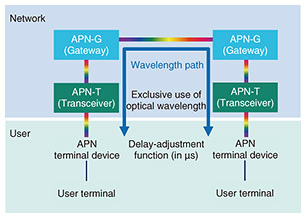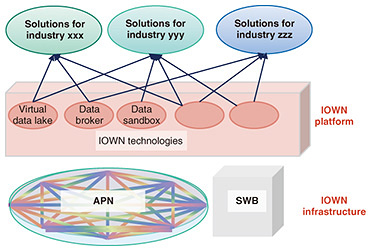 |
|||
|
|
|||
|
Feature Articles: Efforts toward the Early Deployment of IOWN Vol. 22, No. 1, pp. 50–55, Jan. 2024. https://doi.org/10.53829/ntr202401fa6 Efforts of NTT IOWN Integrated Innovation Center toward the Early Deployment of IOWNAbstractNTT established NTT IOWN Integrated Innovation Center to incorporate the concept of the Innovative Optical and Wireless Network (IOWN) as early as possible through the practical application of various IOWN technologies developed by NTT laboratories and the provision of IOWN services/products to meet market needs and social demands. This article presents the activities of NTT IOWN Integrated Innovation Center, which aims to spread IOWN widely and contribute to a transformation of society. Keywords: IOWN, photonics-electronics convergence device, All-Photonics Network 1. IntroductionAs a unique entity among NTT research and development departments, NTT IOWN Integrated Innovation Center was established in July 2021 to accelerate the development of technologies and products related to the Innovative Optical and Wireless Network (IOWN) by bringing together several organizations with development missions within NTT laboratories. This Center was inaugurated by three centers: NTT Network Innovation Center for research and development of network and access systems, NTT Software Innovation Center for research and development of a computing platform and software, and NTT Device Innovation Center for research and development of optical and electronic devices. There is a clear reason for the name of “Center” rather than “Laboratory” because the aim of this organization is to incorporate the IOWN concept in a timely manner for market needs rather than to conduct conventional basic research looking to the distant future. In May 2022, NTT IOWN Product Design Center was established to accelerate the deployment of IOWN, so the total number of centers was increased to four (Fig. 1). While the three aforementioned centers are responsible for the practical application of IOWN-based technologies, the IOWN Product Design Center is responsible for spreading IOWN services and products backcast from market needs by combining those IOWN technologies with current technologies.
2. Target areas of IOWN deployment by NTT IOWN Integrated Innovation CenterNTT IOWN Integrated Innovation Center hopes that IOWN will not only be used within the NTT Group but also be deployed across society so that all people can enjoy the value of IOWN. As shown in Fig. 2, we have defined four layers as the deployment areas of IOWN—semiconductor devices, information technology (IT) equipment, communication networks, and information and communication technology (ICT) solutions—and NTT IOWN Product Design Center plays a central role in promoting initiatives in each area.
2.1 Semiconductor-devices areaFor conventional information and communication systems, optical signals have been used only to transmit information processed by semiconductor devices to other locations. Semiconductor devices have evolved in line with Moore’s Law; however, as the volume of information to be processed increases exponentially, the electrical signals traditionally used to transmit information within equipment or between semiconductors are reaching their limits in terms of speed and energy consumption; therefore, a new breakthrough is required. The photonics-electronics convergence technology that NTT has been researching and developing applies optical and electrical signals to the right place in conventional systems on the basis of conventional semiconductor devices. By using light not only for communications between sites but also at various other levels, it will be possible to achieve compact, economical, high-speed, and low-power consumption devices. NTT has established a roadmap from IOWN1.0 to IOWN4.0 linked with the evolution of photonics-electronics convergence device technology (Fig. 3). IOWN1.0 will apply compact, low-power consumption devices for networks of All-Photonics Network (APN) services. IOWN2.0 will enable the use of light for board-to-board connections inside a server; thus, the application area of light will be extended to the field of computing. IOWN3.0 will enable optical transmission between chips on a board, and IOWN4.0 will enable the installation of optical wirings to the vicinity of a logic semiconductor that executes arithmetic processing. This stepwise evolution will expand the application area of photonics-electronics convergence devices from telecommunications to computing and solve the power-consumption problem with the growing use of artificial intelligence (AI) as a wide range of module vendors, equipment vendors, and hyperscalers adopt these devices. If the use of these devices spreads to consumer domains such as automobiles and mobile terminals, the number of products with the devices is expected to increase to hundreds of millions. As a result, the use of the device per product is also expected to increase, which will significantly contribute to achieving carbon neutrality around the world.
NTT Innovative Devices Corporation was established in June 2023 to commercialize and provide photonics-electronics convergence devices as early as possible. NTT IOWN Integrated Innovation Center will continue to work closely with NTT Innovative Devices. 2.2 IT-equipment areaNTT laboratories proposed an architecture for photonic disaggregated computing that takes advantage of the characteristics of light. In this architecture, photonics-electronics convergence devices provide high-capacity, low-latency connections between accelerators via optical interconnects without central processing unit (CPU) intervention to avoid CPU bottlenecks and improve performance and power efficiency of computing. This architecture enables a computing system to add computing resources on a per-accelerator basis rather than on a per-server basis and allocate the optimal amount of accelerators, such as CPUs, graphics processing units (GPUs), and field-programmable gate arrays (FPGAs), in accordance with the processing executed by each application. Therefore, it is highly expected to improve energy-usage efficiency (Fig. 4).
We are currently researching and developing a super white box (SWB) that adopts photonic disaggregated computing. This SWB will not only be deployed in the NTT Group’s internal systems to achieve our carbon-neutrality goal, but also be widely used by people outside NTT group companies in the form of a server system and an Infrastructure as a Service. We hope it will contribute to carbon neutrality for society as a whole. 2.3 Communication-network areaUsing photonics-electronics convergence devices and the SWB, we will create innovative network services that have never been possible with conventional technologies. One of those services is the APN. It offers each customer a dedicated optical wavelength, and without converting light back to electricity, the light-only connection enables wideband data transmission with low power consumption. APN IOWN1.0 was launched as a commercial service by NTT EAST and NTT WEST in March 2023 (Fig. 5). Since it can provide a communication environment with large capacity, 1/200 delay, no jitter, and zero-latency fluctuation compared with conventional networks, it is possible to create a new user experience that has been difficult with conventional network services. For example, it enables telemedicine and smart factories to perform delicate tasks even from remote locations and guarantees a fair playing environment for e-sports across remote venues. In our demonstration to coincide with the commercial launch of the APN IOWN 1.0 service, the range of applications was expanded to include real-time remote concerts and comedy shows allowing viewers to experience new co-creation and appreciation of arts as well as remote dance lessons, enabling participants to experience a new type of social activity.
In mobile networks, it will also be possible to decrease power consumption of the fifth-generation mobile communication system (5G)/Beyond 5G services by deploying radio base stations with photonics-electronics convergence devices, building the mobile fronthaul based on the APN, and running vRAN (virtual radio access network) software on the SWB. By further developing APN IOWN1.0 and implementing its benefits such as shorter lead times for line installation and expansion, increased capacity and guaranteed network quality compared with the conventional use of dark fiber, we plan to work with our customers to apply APN IOWN1.0 to datacenter interconnects, smart factories, and 6G services. 2.4 ICT-solutions areaIn addition to developing the IOWN infrastructure, such as the SWB and APN for high-speed, large-capacity, and low-power data transmission, NTT laboratories are also researching and developing security technology and data-processing technology that can take advantage of the characteristics of the IOWN infrastructure. For example, these IOWN technologies include (i) virtual data lake, which can obtain and use necessary data from data distributed in multiple locations quickly and efficiently; (ii) data broker, which enables efficient data transmission and reception among multiple locations; and (iii) data sandbox, which allows different organizations to execute data and algorithms while keeping them secret from each other [1]. We will construct the IOWN platform by combining the IOWN infrastructure and IOWN technologies to help many customers address business issues and develop new business solutions in a wide range of industries by using real-time processing of widely distributed data and safe and secure data distribution as the foundation for creating new value (Fig. 6). While expanding the IOWN technologies, we will also develop human resources as consultants with a deep understanding of the value provided by IOWN. We will thus promote various initiatives to create a world where people can widely benefit from IOWN—from the provision of best practices in specific industries to horizontal deployment in other industries.
3. ConclusionThe deployment areas of IOWN targeted by NTT IOWN Integrated Innovation Center were presented in this article. We will promote a wide range of practical applications of IOWN in collaboration with various parties so that various stakeholders can enjoy a new value as early as possible in a more effective manner. Reference
|
|||

















